#Armagnac
Photo

06/30/2023
JUNE OF ARC concludes in a harrowing finale!
I really enjoyed drawing St. Joan of Arc cartoons this month, so thank you all for humoring me!
If you enjoyed them too, maybe we'll do it again next year. We've only scratched the surface of her amazing story!
___
JOKE-OGRAPHY:
1. Camp-followers were women who followed armies around to make money off the soldiers when they stopped for the day. They were prostitutes with bad prosti-'tudes, man. Other people might follow the camps for good reasons (like cooks and priests), but not these ladies.
2. This cartoon is based on witness testimonies from those closest to Joan. According to them, her response to camp-followers was absolute. She kicked out any harlots she found, sometimes with gentle admonitions, and other times with the flat of her sword.
3. I've heard some people question Joan by saying, "She's not very Christian. Jesus WELCOMED prostitutes." Yes, Jesus welcomed prostitutes. REPENTANT prostitutes, who He forgave and then told, "Go and sin no more." He had a very different reaction to the money-changers in the temple. They disrespected His Father's presence, so He chased them off with a homemade whip. Joan's mission was to guide her army in God's Name. She worked hard to make her men go to Mass, receive the sacraments, and adopt behavior befitting servants of God. Like the money-changers, the prostitutes mocked God's presence by their actions and intentions. So, like Jesus, Joan drove them out. Her only fault was not knowing how to fashion a whip of her own, to make the parallel more plain for her SLANDEROUS, PULING critics!
4. "This is a wholesome Christian war-camp!" is a play on the well-aged meme of Christian Minecraft servers, where you can't swear or post naughty things.
5. "I'll make you marry the next man I find you with!" is an actual threat Joan used, according to one witness during her Rehabilitation Trial.
6. "Walloping" is a good word. Catch me outside.
7. I like drawing Joan and La Hire next to each other because she's so tiny.
#joan#st joan#joan of arc#st joan of arc#jeanne darc#st jeanne darc#catholic#christian#medieval#france#armagnac#orleans#wholesome#cartoon#comic#catholic memes#christian memes#catholic humor#christian humor#la hire#wholesome christian war camp
403 notes
·
View notes
Text
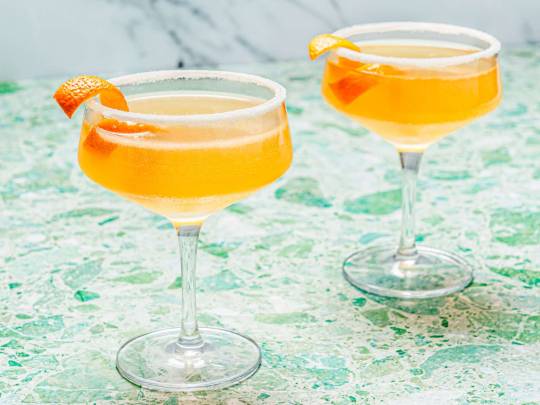
Sidecar !
Ingredients:
2 ounces VSOP Cognac, Armagnac, or good California brandy
1 ounce Cointreau
3/4 ounce fresh lemon juice
Superfine sugar, for garnish (optional)
Orange or lemon twist, for garnish (optional)
Directions:
Optional: Prepare cocktail glass by making a slit in a lemon wedge and running the cut edge around the rim of the glass; then dip the rim in a saucer of superfine sugar to create a thin crust. Chill the glass until needed.
Combine brandy, Cointreau, and lemon juice in a cocktail shaker and fill with ice. Shake well until chilled, about 10 seconds. Strain into prepared glass; garnish with a twist of orange or lemon peel, if the urge comes across.
By Paul Clarke / Serious Eats
This article was not sponsored or supported by a third-party. A Cocktail Moment is not affiliated with any individuals or companies depicted here.
#art#design#cocktails#drinks#cocktail#cocktail recipes#recipes#drink recipes#drink#sidecar#cognac#armagnac#brandy#cointreau#lemon juice#lemon twist#orange twist#paul clarke
19 notes
·
View notes
Text

Booze of France. What's your favorite?
#liquor map#map#liquor#foodglorious-food#foodporn#foodblogger#foodgloriousfood#dinner#foodblog#foodie#whisky#booze#drinking#single malt#gin#vodka#armagnac#ricard#champagne#calvados#pernod#cointreau#chambord#chartreuse#grand marnier#cognac#bordeaux#lillet
30 notes
·
View notes
Text

Battle of St. Jakob an der Birs, 1444 by Alfred Johannot
#medieval#art#battle#switzerland#france#zürich#history#old swiss confederacy#swiss#french#armagnac#knights#middle ages#europe#european#armour#knight#soldiers#war#johannot alfred#alfred johannot#cavalry#pikemen
106 notes
·
View notes
Photo
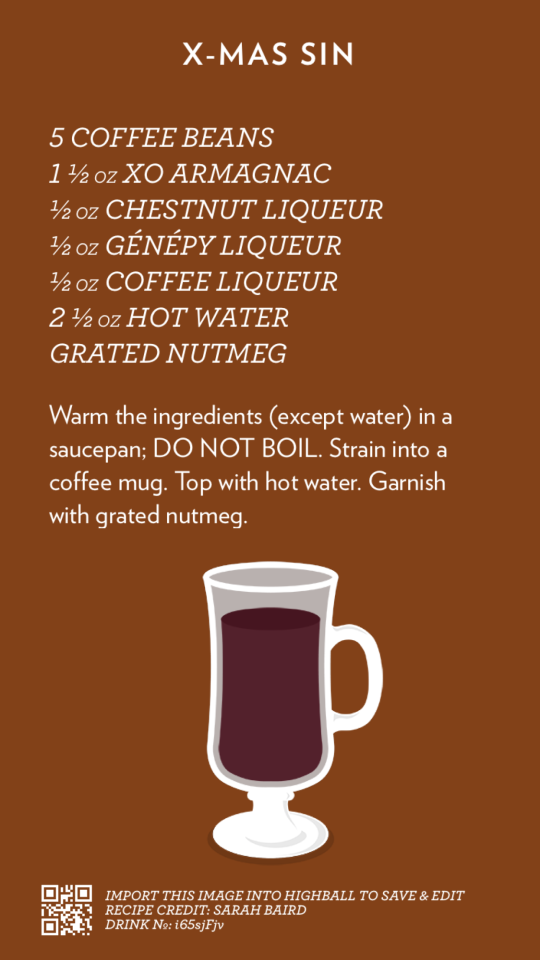
X-Mas Sin
10 notes
·
View notes
Text
Anonymous asked: I enjoy your tumblr tremendously. You manifest an appreciation, perhaps passion, for Scotch Whiskey. Firstly, do you consider fine Japanese or Australian whiskey equally good? Secondly, do you also enjoy Armagnac and Cognac? Personally, I find the former often overlooked and, generally, better value. What do you think? Thanks!
I’m very much a wine drinker these days and being a co-owner of a French vineyard has made me more immersive in that world of appreciating fine wines, its traditions passed down from generation to generation on wine making, social customs that are the fabric of particular way of living and enjoying life. By the very act of drinking the wine you are being a part of the terroir (a hard word to define but generally meaning ‘of the soil’) of where the wine was made.

There are a lot of similar reasons to drink whisky of which I used to drink a lot, especially when I was an army officer and drinking games in the officers mess was the done thing. But these days I drink in extreme moderation and often with a well deserved cigar. Some people like the way it makes them feel fuzzy and warm, when laughing comes a little easier. Maybe it takes the edge off a long day or helps hype the anticipation for what might be a long night. For me, the reasons why I love whisky are much more than that.
Like wine, whisky tells us a story. In my case a Scottish story as one side of my family have strong roots in that part of the world, and are still thriving there. It tells a story of a certain time and a certain place, of a distillery and those who work in it. I love the idea that an entire team of people worked every day to grow barley, distill whisky, maintain a distillery, patiently watch over barrels, and the million other minute tasks that go into creating a single bottle of whisky that is then transported locally and all over the world for me to enjoy. And when I’m holding a 20 year old Aberfeldy single malt in a Glencairn glass on the other side of the world, I can take one sip and feel myself transported all the way back to the central Highlands.

And it tells a story on an individual level, too. What inspired me to buy the bottle and where I got it. Maybe it starts with how I learned about it or where I first tried it and weaves until here and now, to who I’m drinking it with and when. So when I sip on any Dalmore whisky I sometimes think of meeting Dalmore’s master distiller, Richard Paterson, who wowed me with his infectious love of his craft and old school bonhomie as he led a sampling some of Dalmore’s finest single malts at the distillery.
Like wine, whisky is a life time journey of discovery from following the aromas and flavours of each dram. From the Scottish Lowlands where whiskies are often light bodied, delicate, soft, smooth, and have very little peat, and they’re malty and citrusy with flavours of grass, honeysuckle, cream, ginger, toffee, toast and cinnamon; to the Scottish Highlands where whiskies are full bodied and spicy whiskies, lighter and fruity whiskies and those that are full bodied, peaty with a salty tang from the sea. From Speyside where its famed single malts are both light and bold whiskies that are sweet, fruity and spicy with hints of apple, nutmeg, vanilla and smoke; to Islay where the famed Scotch can be peaty, smoky, earthy and oily with a hint of salty sea air, brine and seaweed. Whiskies then need to be explored and as one becomes more skilled at detecting aromas and flavours; and as one tries more whiskies, one finds more aromas, flavours, and even more whiskies that tantalise the palate.
Which is why I’m not particularly tribal about whisky.

I wish I could compare Japanese and Australian whisky and give you my opinion if they are equally good. But I can’t. My knowledge and experience of drinking Australian whisky is dire compared to how much I’ve enjoyed Japanese whisky over the years. I’ve been to Australia on a few occasions and I’ve even gone on a few wine trails to widen my knowledge of the Australian wine making industry and learn lessons from them for our own wine making back in France. But on the side I did sample some its home grown whiskies.
I recently had a tipple of the Starward Two Fold, given to me by an Aussie work colleague and I tried it more out of curiosity than any real knowledge. The one I had had spent time in Aussie shiraz and pinot noir wine barrels before it was bottled, making for a blend of spicy and caramel notes. Apparently it won five gold medals at the World Whiskies Masters (2022). Hailing from Victoria’s New World Whisky Distillery, Starward have been favoured by many for their innovative approach to modern whisky production, eschewing the traditions that bind so many other distillers and producing consistently interesting whisky. Their whiskies are all made from Australian barley, aged in Australian barrels and reflect the terroir with subtlety. And then finished in Australian wine casks. I think it’s an excellent entry point into Australian whisky and at a decent price too.
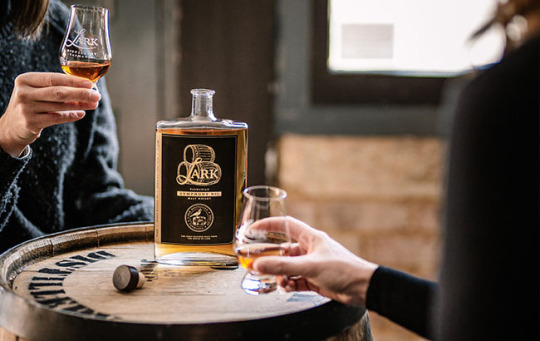
I’ve had the Lark’s Classic Single Malt with its hints of citrus and butterscotch and it’s peated too with a lovely balanced smoky woodiness and vanilla. Also from the Lark’s stable I’ve had tipple of Lark 9 year old Bourbon cask whisky which has a lot more complex notes. Lark of course is at forefront of Tasmania’s whisky growing region with other whiskies such as Sullivan’s Cove and Bakery Hill, also adding to the growing prestige of whiskies made in Tasmania.
I love the story of how Lark began. Apparently, founder Bill Lark was trout fishing with his father-in-law Max in the Tassie highlands that the two scratched their heads and said: “I wonder why there isn’t anyone making malt whisky in Tasmania.” The climate, access to barley, natural peat bogs and pure, soft water were all in abundance, but nobody had connected the dots for over a hundred years due to archaic licensing laws. Since then, Bill Lark worked tirelessly to promote the Southern island as one of the world’s best whisky-producing regions, all the while expanding his eponymous distillery from a small apparatus in his kitchen to a huge copper still which gets put through its paces to keep up with demand. Apparently, the operation is still a family affair and the distillery itself has undergone a recent world-class makeover. Now that’s a story to worth raising your dram to.

Of course Australian whisky is still startlingly a niche thing, even within Australia, with Starward its leading domestic producer accounting for 66% of Australian whiskies 1% share of the market. What I understand from Aussie work colleagues who are whisky aficionados is that 50% of the Australian whisky market has been bourbon. Jack Daniels accounts for over a quarter of the market with 26% and it accounts for 52% of American whiskies sold in Australia. Jim Beam has a respectable 10% and 20% across those sectors, and Makers Mark is third. Rye whisky accounts for just 0.72% of the total sales, with Woodford Reserve (34%), Bulleit (32%) and Michters (11%) the leaders.
Scotland holds 27% of the total market - blends and malts. Johnnie Walker dominates with 15%. Chivas Regal represents 2% of total sales. Glenfiddich 12-Year-Old Single Malt leads the Single Malts (Scotland) category with 1.7% (6% of total Scotch, including blends). Lagavulin, Laphroaig and Talisker all equate to around 1% each. Given that these are relatively small and distant distilleries, it does suggest that the smoky/peaty style from Islay is beloved by malt drinkers in Australia.
Japan comes in with 1.5%, with Hibiki dominating - their 12-Year-Old has 25% of the market and their 17-Year-Old has 30%.
It would seem that the era of Covid, closures, cuts and chaos is proving to be an exciting time for whisky in Australia. The story seems to be Australian whisky is enjoying dynamic growth. The growing demand through volume for Australian whisky is primarily in Asia. Australian producers are now entering partnerships with specialist whisky markets like Japan and Taiwan which has seen an incredible uplift on single cask requirements (cask strength, finishes, aged statements).
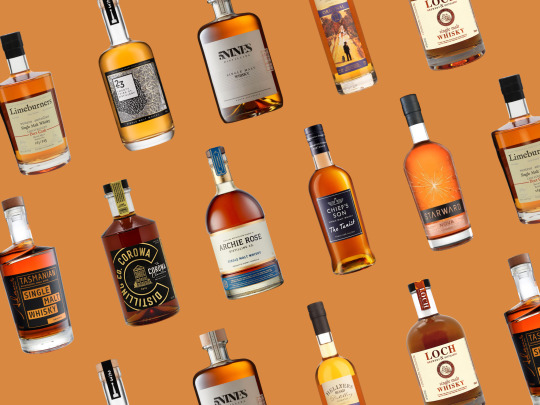
Australian Distillers Association figures reflect this growth. The number of registered Australian distilleries almost doubles from 2021-2022, growing from 200 in January 2021 to 380 in February 2022. There is no question that Australia could be the next break out whisky nation once prices become more competitive to other foreign producers and it has greater market visibility outside of Australia. Just as importantly the whisky market is young. The number of 25-34 year olds drinking whisky has doubled in the past six years and around 19 million glasses of whisky are drink every month.
What it also has going for it is the land’s natural resources ie the earth (or the terroir as the French winemakers call it). Australia is one of the largest malting-grade barley producers in the world, with many varieties unique to the country. Whisky producers increasingly work more closely with a number of New South Wales’ farmers to get hold of unique malts which demonstrate regional terroir. It allows all concerned to develop a relationship with the land and their custodians, exploring ancient and heirloom varieties. Surely, that’s a good thing.
It also allows for these whisky producers to experiment and take creative risks both in the way they can source the variety of grains and also explore ‘paddock to bottle’ with barley. The end result is Australian whisky can frustrate anyone to categorise it into easy tick boxes. That’s a good thing too.

Finally, it would be remiss to talk about Australia’s natural resources without alluding to its vineyards. The country’s winemaking history has granted distillers access to some truly fantastic ex-fortified wine casks, particularly Apera. Australia’s answer to sherry, Apera, is made from a different blend of grapes, but still has many similarities in style. Many of these casks have been around for decades - indeed, whisky producer Archie Rose has filled casks that contained Apera for more than 70 years.
Australia can learn from Japan’s experience of whisky, namely, concentrate on producing great whisky for the world to enjoy and most importantly, take your time.
I know a lot more about Japanese whisky as I grew up partly in that culture as a child when we lived overseas but also been a frequent visitor there for work reasons. I think a good explanation for why Japanese whisky is so good is that Japan’s distilleries typically adhere to Scotch methods, but the country’s distinct seasons have a significant impact on the maturation process - the cold winters slow the ageing of the spirit, while the humid summers speed it up. A variety of casks are used in the ageing process, but the country’s indigenous lumber, most famously mizunara (Japanese oak), ages unique whisky that’s subtle, yet strong. Unlike their Scottish counterparts, Suntory and Nikka, the two giants of Japanese whisky, distil a mind-boggling array of whiskies in-house, giving them great control over their products and enabling them to experiment with different whisky-making techniques.

The history of Japanese whisky is shrouded in mystery, since very little is recorded in whisky making before the famed establishment of Suntory’s Yamazaki Distillery in the early 20th century. What we do know is that a few shochu and sake breweries produced Japanese whisky on the side as early as the 1850s. Whisky took a historical turn in Japan in 1923, when Suntory established the first official whisky distillery. But it was when Suntory’s domestic market for whisky collapsed and it and other rival producers such as Nikka focused on producing the best single malt whiskies it could did Japanese whisky gain global recognition with countless international awards and has been in high demand from whisky lovers everywhere.

Today, the companies of Masataka Taketsuru (Nikki) and Shinjiro Torii (Suntory) still represent their founders’ passion for Japanese whisky. Masataka Taketsuru was known as the “Father of Japanese Whisky” and studied the intricate whisky-making process in Scotland. He took his knowledge and his newly wed Scottish wife, Rita, back to Japan and established one of the most popular Japanese Whisky companies: Nikka Whisky. Shinjiro Torii was the founder of Suntory, known as Kotobukiya back then, and built Yamazaki in 1923. However, Taketsuru and Torii had a history before these two companies were born. Taketsuru actually worked in Torii’s company for over 10 years, so the Suntory and Nikka whisky companies have a background story that is linked to each other. Taketsuru came from a family who had a sake brewery for Japanese alcoholic beverages. He studied chemistry at the University of Glasgow to improve his understanding of creating alcoholic beverages.

Taketsuru and Torii became business partners. But their search to find a whisky that the Japanese people could like and claim as their own came to nought. Torri, the business brains, wanted the distillery to be near as possible to Tokyo and have billboards plastered at key points where trains would go by. Taketsuru, the perfectionist, wanted to move further north to produce whisky as he was convinced the climate and soil up there would be more conducive to great whisky. Eventually they went their separate ways. Taketsuru ventured out on his own in 1934 and established the Yoichi Distillery in Hokkaido in 1940.
Suntory originally offered an alcoholic beverage called Akadama Sweet Wine, which was a huge success for the company and continues to be produced today. However, Shinjiro Torii wanted to create a whisky that suited the Japanese people’s preferences and moved forward with the establishment of Yamazaki Distillery, despite the opposition he received from his business partners. In 1929, Torii created the first whisky from Suntory called Suntory Shirofuda (‘White Label’), but it turned out to be unsuccessful because it didn’t fit the tastes of the Japanese consumer base. The second whisky released from Suntory was the Suntory Kakubin, which became a hit and continues to be Japan’s #1 best-selling whisky.
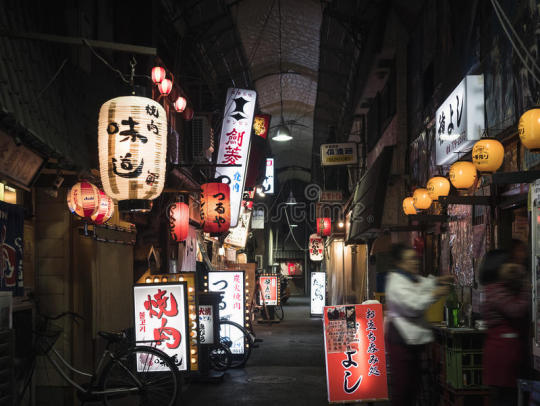
To spread the knowledge and passion for Japanese whisky, Suntory opened whisky bars around the country in 1955. In 1970, Suntory revolutionised how the Japanese food and drinking culture by creating the “Mizuwari,” a water-and-whisky drink that was easy to drink and enjoy with Japanese cuisine.
However domestic whisky market began to collapse for not just Suntory but other domestic whisky producers in the 1990s. The culture was changing. No longer were young salaried men drinking whisky as their bosses did - it was seen as a rite of passage. They instead preferred vodka and other spirits now making inroads into the Japanese drinks market. Increasingly whisky came to be seen as ‘an old man’s drink’. Sales plateaued and Suntory focused on other parts of their drinks and food empire. Suntory, along with Nikka, began to focus on producing high end single malt whiskies that could makes its debut to the outside world. This only bore fruit a decade later in the 2000s when Japanese whisky started to winning prestigious awards for its whiskies.

It’s an open question whether the rise of Japanese whisky was also due to the product placement of tis whisky in the cult movie ‘Lost in Translation’ in 2003 which featured Bill Murray’s character advertising Suntory’s whisky with the memorable quote: “For relaxing times, make it Suntory time!” Some have argued that the movie helped in boosting the exposure of Japanese whisky as international whisky lovers gradually discovered this luxury spirit from Japan. At the very least, the Hollywood exposure it didn’t hurt. In 2003, Suntory’s Yamazaki 12 Year Old won the Gold Award at the International Spirits Challenge in the UK and it was part of a wave of outstanding awards for Japanese whiskies.
Oddly enough, whisky is back in favour with the Japanese. In more recent years, the Japanese whisky business has boomed and become even more popular within Japan and out of the country. The Highball drink, a simple mixture of Japanese whisky and soda, has become a staple to drink with Japanese dishes.
Suntory's Yamazaki 12 Year Old continues to impress with its well-balanced fruity sweetness, something that appeals to novice and experienced whisky drinkers alike. I would say it’s the original Japanese whisky and remains Suntory’s flagship single malt. Yamazaki is multi-layered with the aromas of fruit and Mizunara Oak. Even today, Yamazaki is the leading single malt whisky sold in Japan, and enjoyed in more than 35 countries. It’s an excellent entry point into Japanese whisky.
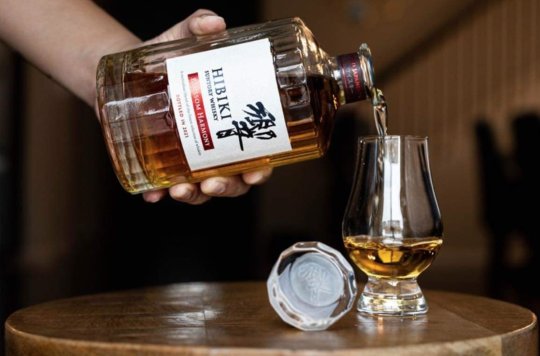
I would also recommend the Hibiki Blossom Harmony. Blending is a key component of the craft of making Japanese whisky. Great care and attention is paid to flavours and proportions, with some distilleries producing dozens of different whiskies that are combined into the final product. Hibiki, a blend from Suntory, launched in 1989, and there are now several different expressions in the range. The 17-year-old version is probably the best, an incredibly well-rounded sipper with lovely notes of orange peel, caramel, and toffee.
As for armagnac and cognac, I would agree with you that generally the former is overlooked when actually it is better (my opinion). It is the only spirit that can really become more refined with age. Before I moved to France and before I decided to invest in a vineyard with my cousins, I was quite happy drinking cognac as an after dinner drink - to go with my cigar that I smoked with the men. I wasn’t really aware of armagnac until I saw it increasingly being served around the French dinner table. I enjoyed the experience and it set me off on a little side journey of exploration.
I hadn’t realised that it was France’s oldest brandy for over 700 years but talk to locals and they derisive of calling armagnac a brandy. It’s closer to wine. The production of Armagnac has been documented since 1310, when Vital Dufour, prior of the town of Eauze, described in his ‘Livre très utile pour garder la santé et rester en bonne forme’ the advantages of a brandy known as aygue ardente. Armagnac appeared thanks to the meeting of two civilisations: that of the Arab world and its still, and that of the Christian world and its monks who planted vines. It does not yet bear the name of today. It was then an apothecary’s remedy. In 1461 it was found on the market of Saint Sever. It became a drink that was appreciated for its gustatory qualities, a drink called “le merveilleux”. Historically, Armagnac is a precious brandy, but confined in the margin of the wine production of the region.

As you well know Armagnac is produced in the South-West region of France, the Gers department, the East of the Landes, and the South of the Lot-et-Garonne; whereas Cognac is produced 300 km further North in Charente, Charente-Maritime, parts of the Dordogne and Deux-Sèvres - where it so happens a lot of British expatriates reside permanently or have a second home.
The terroirs are distinguished by their soils and climate, which give their brandy their typical character. The Cognac soil is mainly limestone, while the Armagnac soil is sandy, clayey-siliceous and clayey-limestone. The Armagnac region has a continental climate, while the Cognac region has a more oceanic climate. Part of the reason why I was drawn to armagnac was variety of grapes used. You know that cognac is made from the Ugni Blanc grape only, whereas Armagnac is made from 10 different grape varieties, including Ugni Blanc. The diversity of grape varieties authorised by the AOC Armagnac decree is due to the viticultural tradition of the region which also produces tasting wines. The Cognac region only produces wine for distillation.
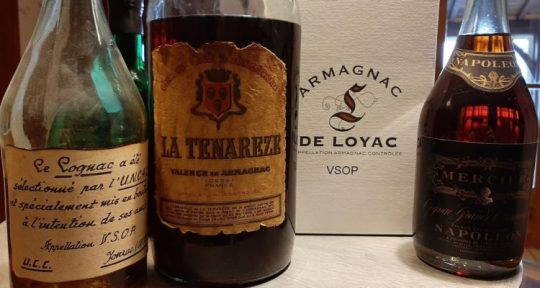
Where the full flavour of armagnac comes out above cognac is how they are made. Armagnac is column-distilled, which is a process where the alcohol is continuously heated between two vertical columns and then aged in French oak barrels or casks for a minimum of 1 year. Though Armagnac and Cognac are both are brandies distilled from wine, Armagnac is distilled once while Cognac is distilled twice. Indeed the still used for the distillation of Cognac is different from the one used for Armagnac. The Cognac or “Charentais” alembic is a basic copper alembic c” (double heating): the alcohol is distilled twice and the brandy comes out with a higher alcohol content (72°). The Armagnac still is a double-column copper still with trays, for a continuous distillation: the wine is distilled only once and the brandy comes out with a low alcohol content (54°).
The plates of the Armagnac still allow the alcohol vapours to bathe in the fresh wine and extract its aromas: this is the bubbling. This step does not exist in the Cognac still where the alcohol vapours do not meet the fresh wine. Its ageing links it to the culture of wine and distinguishes it from other brandies. Like wine, Armagnac can be vintage to reflect the history of the year. Cognac is gradually diluted with distilled water to reach its 40-45° for sale. The brandy, “burned” by the alcohol, cannot evolve.
To my mind, armagnac and cognac have two singular historical trajectories, which influence their current reputation. Armagnac has developed on a French consumption model. Its more confidential artisanal production perpetuates ancestral know-how. Cognac was conceived for an export market to the Netherlands and England. It mirrors the story of the battle between Bordeaux wines and Burgundy (or Bourgogne) wines. Bordeaux wines were made from a blend of grapes and produced for an export market to the English primarily whilst Bourgogne has been a single grape and very much towards a home grown market.

If I have any visitors to France I always introduce them to armagnac if I can. Armagnacs exalt the richness of that South West region’s gastronomy: foie gras, chicken in a pot, duck breast. They go particularly well with dark chocolate cake, almonds and dried fruits, walnut pie or orange macaroons.
It’s great as an after dinner liqueur. The sweet flavours of Armagnac make it a perfect after-dinner drink. I would also choose an older armagnac as a rule older is always better so go with a vintage armagnac. But not always as when drinking clear Armagnacs - known as Armagnac blancs or Haut-Armagnacs - which have spent less time in the oak ageing barrels - one can enjoy them on the rocks or chilled in the fridge. I particularly love to end a meal at a restaurant having an Armagnac Brûlot - in other words, flambé, using sugar to set it on fire. It’s a great way to end a pleasant dining experience.
But armagnacs are also perfect for cocktails as a pre-dinner aperitif or lounging around a swanky hotel bar. I would highly recommend the Armagnac Stinger, a cocktail, originally served with Cognac, was a pre-Prohibition American favourite. It combines Armagnac, crème de menthe, orange bitters, and garnish with a sprig of mint. There is also the D’Artagnan, which combines armagnac, orange liqueur, orange juice, simple syrup, and finished off with a splash of champagne - perfect for partying. The Continental Sour is another cool one which mixes together armagnac, egg whites, simple syrup, lemon juice, and red wine.
Whatever one drinks, be it armagnac or cognac, I believe in its conviviality for cultured conversation and good natured laughter (at your own expense) over a shared meal with like minded people, be they family and friends. The French love arguing over a fine meal. The arguments can be heated and robust but they are never personal and drink is the balm to bring people together again. If you bear that in mind then you can’t go wrong.

Thanks for your question.
#question#ask#drink#drinking#alcohol#scotch whisky#whisky#japanese#australian#aqua vita#armagnac#cognac#french#france#farming#wine#culture#personal
41 notes
·
View notes
Text
Live laugh love, adore Isabelle d' Armagnac
#i adore her#Isabelle d' Armagnac#Isabelle of Armagnac#lady of the four valleys#🎵inc$st never bothered me anyway🎵#royals#royal history#nobles#france#french royalty#armagnac#isabelle#she's also a descendant of my dear#eleanor of aquitaine
2 notes
·
View notes
Text
Hortelano al armagnac, un plato prohibido
La serie Billions retrata a la perfección el ritual que se hace al comer este plato / Foto: Netflix
Hay preparaciones que, aunque puedan ser todo un manjar, generan polémica por sus métodos de preparación. Tal es el caso del hortelano al armagnac, una receta que, incluso, está prohibida en la Unión Europea.
El ingrediente principal de esta receta es el escribano hortelano (Emberiza hortulana). Esta es un ave pequeña que destaca por sus buenas propiedades para fines gastronómicos, algo que lo ha hecho estar bajo amenaza por años. Es típica de gran parte del continente europeo, aunque también se puede encontrar en zonas de África y Asia.
Este peligro que corren estos gorriones ha hecho que su captura sea ilegal y, por ende, que también lo sea el consumo del hortelano al armagnac. Esto no solo por la posibilidad de poner al ave en peligro de extinción, sino por el método de elaboración del plato, que se hace desde el siglo XVII.
Los detalles del polémico hortelano al armagnac

El ave se cocina entera luego de ahogarla en armagnac / Foto: MadameLefigaro.com
Para esto, el escribano hortelano se captura de manera ilícita, principalmente en Francia. Luego se encierra en cajas, totalmente a oscuras, para alimentarlos de manera forzada con granos, entre los que destaca el mijo, para engordarlo. Esto es algo que les aporta bastante grasa y hace que sus huesos sean más suaves.
Luego, las aves se sumergen vivas en un recipiente con armagnac, un tipo de brandy producido en la región francesa homónima. Ahí, los pájaros se ahogan y se dejan marinar por un tiempo para que tomen sabor. Finalmente se cocinan de diversas maneras, usualmente asados.
Aunque es una receta prohibida, hay restaurantes que aún lo ofrecen, siempre de manera clandestina y con precios elevados. A la hora de comerlo, también se sigue un ritual muy específico, el cual implica cubrirse con un manto blanco mientras se degusta la preparación con las manos.
Sobre la razón de esta práctica hay diversas explicaciones. Para algunos, es una tradición que nació por la necesidad de “ocultarse de Dios” por cometer un acto considerado cruel por muchos. Mientras, otros creen que simplemente se trata de una forma de cuidar la intimidad del comensal, que debe usar sus manos para ir comiendo el ave entera a la vez que escupe algunos huesos. Asimismo, hay quienes indican que se hace para poder apreciar mejor los olores de la comida.
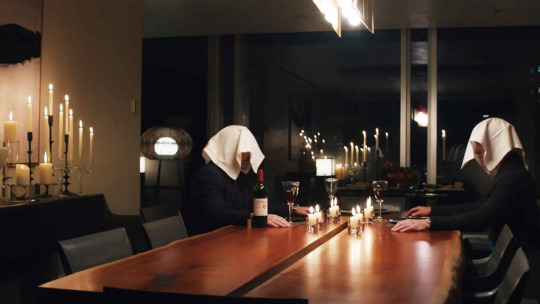
Comer este plato prohibido implica taparse con un trapo blanco / Foto eater.com
Debido a su carácter prohibido, pocas son las referencias que se encuentran del plato. En su portal web, Condé Nast Traveler compartió el testimonio del cocinero Lluís Bernils. En 1993, el chef fue a una cena especial en el restaurante Can Fabes del chef Santi Santamaría.
“Me dijo que tenía una sorpresa fuera de carta que se comía con las manos y que me la servía con una condición: seguir un ritual o me retiraría el plato”, comentó Bernils a CNT. Según explicó, en un principio tuvo algo de vergüenza. “Sólo me animé a hacer el ridículo cuando otro comensal solitario, que resultó ser un inspector de la Guía Michelin, se tapó con su servilleta para iniciar el ritual“, dijo.
Años después de probarlo, comenta que no repetiría la experiencia, pues ahora es mucho más consciente del maltrato animal que implica el plato.
2 notes
·
View notes
Text
Recette Tarte aux poires

La tarte aux poires est un dessert délicieux et facile à préparer qui peut être apprécié par tous les amateurs de pâtisseries. Cette tarte est composée d'une pâte feuilletée croustillante et d'une garniture fondante à base de crème, de sucre, de poudre d'amandes et d'armagnac. Les poires, pelées et coupées en deux, sont disposées en fleur sur le dessus de la garniture et légèrement enfoncées pour une présentation élégante. Cette tarte aux poires est le choix parfait pour un dessert rapide et délicieux à servir à tout moment de l'année.
youtube
2 notes
·
View notes
Photo

Check out theseFrench cognac or armagnac pipe snifters. I think the letters are made of pewter. I have never seen anything like this before. #Armagnac #cognac #French #thriftstore #goodwillfinds https://www.instagram.com/p/Cpgieg9ptRh/?igshid=NGJjMDIxMWI=
2 notes
·
View notes
Text

armagnac; fransanın güneybatısında üretilen bir brendi türü aslında.
babamın alkol dolabını açtıktan sonra elime geçen, en az 25 yıllık olan ve etrafımdan çok da değerli bir içki olduğunu duyduğum, bizim için anlamı büyük bu şişeyi abimle birlikte, biraz da bozuldu mu acaba korkusuyla, açtık ve içtik.
sonuç; mükemmel. bu kadar sert olup bu kadar yumuşacık olan bir şey içmedim ben. değerli içki denilen şey böyle mi oluyormuş diye de düşündürdü :)
babamın şerefine…
2 notes
·
View notes
Photo

06/02/2023
Join Tomics for a month of comics dedicated to one of history's most intense soldiers, saints, and women!
It's JUNE OF ARC!
___
JOKE-OGRAPHY:
1. St. Joan of Arc was a French peasant girl during the Hundred Years’ War. If you haven’t heard of her, get on it. She’s one of the most heavily documented people from that time period because of her excommunication trial by the Catholics in England, then her posthumous un-excommunication trial by the inquisitor from Rome. Quite a long paper trail for someone who couldn’t read.
2. In this cartoon, Joan rallies her men before they charge into battle. One man says he’s packed white flags for when they want to surrender. Preparing to surrender before the battle even begins is quite silly, and thus, a joke. The man is a joke, and his progeny will weep for sharing his blood.
3. Also I think it became a popular joke at some point that the French are cowards. Joan must not have got the memo.
4. Joan orders the men to stop passing around white flags, telling them instead that they’ll be using her banner. While Joan means that they’ll be charging into battle full of confidence with her at their lead and God on their side, the French soldiers think she means that SHE’LL be waving the biggest white flag of all so the English can see their surrender.
5. Look at that “dude r u 4 real?” face.
#joan of arc#st joan of arc#catholic#christian#hundred years war#english#french#armagnac#soldier#medieval#banner#tomics#tomics comics#tom gould#i guess ill just be drawing flour delis all over the place for a month#yes#flour delis#its 3am in a warehouse
301 notes
·
View notes
Photo

#latergram Shoutout to @mars7980 for letting Seiko and I try so many different Kentucky bourbons, armagnacs, and @screwball_whiskey on our trip back home. Stagg Jr. is now my all time favorite. #ケンタッキー #バーボン #ウイスキー #アメリカ #酒 #最高 #スタッグジュニア #アルマニャック #ピーナッツバター #ピーナッツバターウイスキー #america #kentucky #bourbon #bourbonwhiskey #stagg #whiskey #armagnac #peanutbutter #weller #woodfordreserve #elijahcraig #boonecountydistillingcompany #bookers #coloneltaylor #dartigalongue #skrewballwhiskey #drinks #alcohol #tasty (at Florence, Kentucky) https://www.instagram.com/p/CmDRDYNJSVX/?igshid=NGJjMDIxMWI=
#latergram#ケンタッキー#バーボン#ウイスキー#アメリカ#酒#最高#スタッグジュニア#アルマニャック#ピーナッツバター#ピーナッツバターウイスキー#america#kentucky#bourbon#bourbonwhiskey#stagg#whiskey#armagnac#peanutbutter#weller#woodfordreserve#elijahcraig#boonecountydistillingcompany#bookers#coloneltaylor#dartigalongue#skrewballwhiskey#drinks#alcohol#tasty
3 notes
·
View notes
Photo

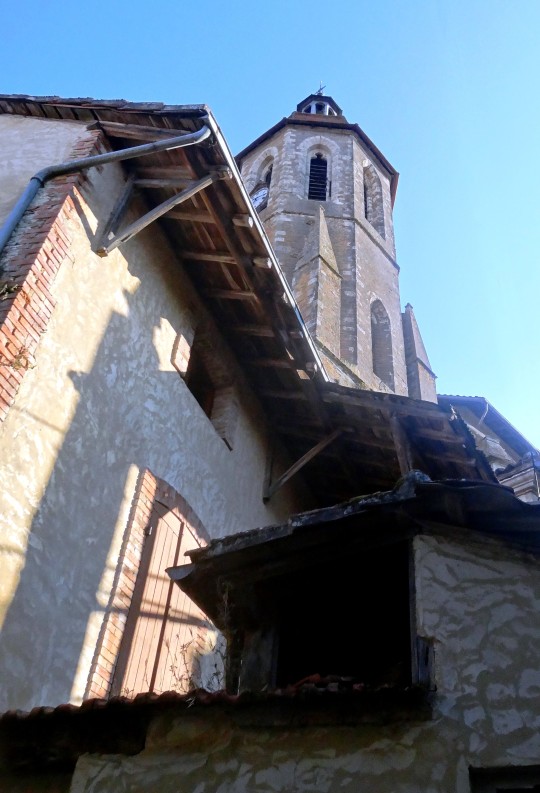
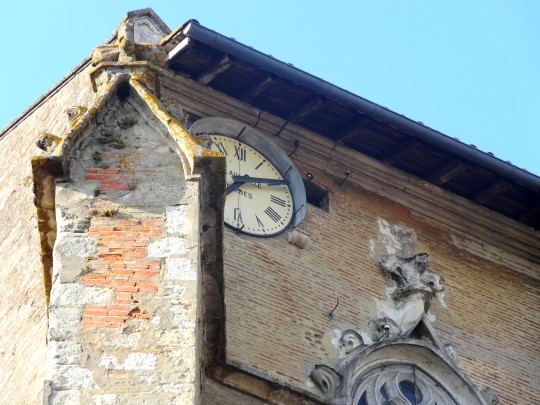


Je reviens à mon projet de présenter la plupart de mes 54110 photos (nouveau compte )
2014. Comme chaque année, je passe quelques jours chez Christine à Pau.
Une virée dans le Gers.
- les 3 premières :Eauze, capitale de l’Armagnac.
- les 2 autres : Nogaro
3 notes
·
View notes
Photo

Iniziamo la settimana preparando tutto per salutare il 2022 e dare il benvenuto al 2023. Per dire “ Au revoir” al 2022, durante la festa di fine anno proporremo l’Armagnac ai nostri ospiti. Originale e molto alla moda, perché dona un tocco di eleganza e di prestigio. Si tratta di un brandy distillato esclusivamente da vino bianco. Prende il nome dall'antica contea di Armagnac, il cui territorio storico corrisponde all'attuale zona di produzione. Tra tutti i distillati, l'Armagnac è l'unico a possedere questa incredibile capacità di essere perfettamente associato a molti piatti, dagli antipasti ai dessert. A me è stato consigliato di abbinarlo ai cioccolatini per concludere in bellezza le nostre cene con gli amici. E voi conoscevate l’Armagnac? Con cosa lo abbinereste? Thanks to @explorefrance @barbara.lovato #ExploreFrance #Armagnac #armagnacstyle @baciperugina_it #dolcegabbana #baciperuginadolceegabbana (presso Piacenza) https://www.instagram.com/p/CmqsOEYMzmF/?igshid=NGJjMDIxMWI=
2 notes
·
View notes
Photo

Smoking Pistol
2 notes
·
View notes